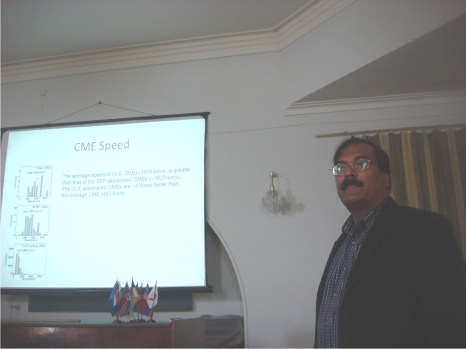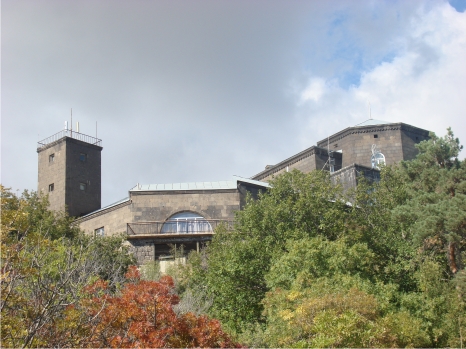
| 2008-10-03 10:06:43 |
|
International workshop in Armenia: “Forecasting of Radiation and Geomagnetic Storms by networks of particle detectors”
Summary and recommendations
The International Workshop: “Forecasting of Radiation and Geomagnetic Storms by networks of particle detectors” (FORGES-2008) was held on September 29 - October3, 2008, in International Conference Center, Nor Amberd, Armenia, 40 km from Armenia's capital Yerevan. The focus of the Symposium was pointed on the Space Weather drivers and on possibilities of the networks of particle detectors measuring changing fluxes of neutral and charged particles to forewarn on upcoming severe radiation and geomagnetic storms. 40 scientists and students from Germany, Italy, Great Britain, Croatia, Greece, Ukraine, Russia, USA, Costa-Rica and Armenia listen to 8 invited lectures and 25 original Papers covering following topics:
-
The Physics of the Interplanetary Coronal Mass Ejections (ICME), their origin and propagation in the interplanetary space and interaction with cosmic rays and magnetosphere; modulation effects posed on the galactic cosmic rays; classification of the geomagnetic storms (GMSs).
- Characteristics of the ground-based networks of particle detectors; experimental methods of measuring count rates and energies of secondary cosmic rays; efficiency of detecting various species of secondary cosmic rays. Detection of most important solar transient events of the 23rd Solar Activity cycle; Recommendations to further development of the Aragats Space Environmental Center (ASEC) .
These reports focus on the location and design of particle detector networks required for early recognition of approaching ICME “patterns”. These patterns should reflect the size, direction and “frozen” magnetic field in ICMEs. Registering simultaneously charged and neutral fluxes of secondary cosmic rays with particle detectors located at different latitudes and longitudes at high altitudes can help solve this extremely difficult problem.
- Mathematical methods of the prediction; feature selection; Bayesian and Neural Network models of interpolation and extrapolation; multivariate regression methods.
For solving forecasting problems the most convenient are multivariate nonparametric models, trained on the data bases of recorded geomagnetic storms with all related solar and geophysical parameters. The key problem is the selection of the optimal feature subset for prediction.
- Training of SEVAN network host groups.
The United Nations Office of Outer Space Affairs and the International Heliophysical Year (IHY) have launched a small instrument programme as one of United Nations Basic Space Science (UNBSS) activity. A network of particle detectors located at the middle to low latitudes, SEVAN (Space Environmental Viewing and Analysis Network) aims to improve the fundamental research on particle acceleration in the vicinity of sun and space environment conditions. First SEVAN modules are under test operation at Aragats Space Environmental Center in Armenia. The network will grow in 2008 with detectors deployed in Croatia and Bulgaria. In 2009 SEVAN detectors are planned to be installed in Slovakia and Costa Rica. Research groups from Croatia and Costa-Rica were introduced to the SEVAN detector operation and data analysis.
During numerous discussions the answer to the main topic of the workshop and recommendation to ASEC development materialized in the following statements:
The key issue of the Space Weather (SW) research is better understanding of the physics of most energetic processes on the sun, on the propagation of the ICME in the interplanetary space and its interactions with magnetosphere. The excellent facilities of the ongoing and planned space missions will bring direct information about processes on the sun and in vicinity of Earth. Secondary fluxes of elementary particles measured on the Earth surface can provide compatible information on highest energy solar cosmic rays and on the modulation effects solar activity poses on the ambient population of galactic cosmic rays.
Particle detectors located at Aragats Space Environmental Center (ASEC), measure charged and neutral secondary fluxes and access wide energy domain of the primary cosmic rays. Planned SEVAN particle detectors network also will measure different components of secondary cosmic rays at different latitudes longitudes and altitudes. This 2 types of networks, one located in one place and another distributed worldwide can inter-calibrate each other and provide detailed information on solar transient events (Forbush decreases, Geomagnetic Storms, Ground Level Enhancements) and detect precursors of approaching Geomagnetic and Radiation storms.
Taking into account the importance of electromagnetic fields measurements for space particles fluxes monitoring it is recommended to apply for special funds for the installation of electromagnetic stations at Nor Amber and Aragats observatories.


Figure 2 Presentation of Vahe Peroomian, University of California, USA

Figure 3 Valery Karepanov, Lviv Center of Institute of Space Research, Ukraine; Bagrat Mailyan, Mery Zazyan, both Cosmic Ray Division, Yerevan Physics Institute, Armenia; Rainer Hippler, University of Greifswald, Germany; Gagik Hovsepyan and Armen Hovhannisyan, both Cosmic Ray Division, Yerevan Physics Institute, Armenia.

Figure 4 View of the Nor Amberd International Conference
Center; after recent repairs 20 rooms
can provide comfortable accommodation to 30 guests; lecture hall equipped with
modern laser-projectors have 100 seats; computer class and wireless Internet
are available to conference participants.

Figure 5 Excursion to the Aragats research station, 3200 m above sea level.
